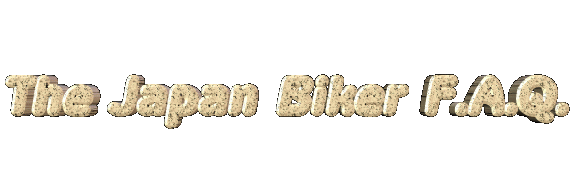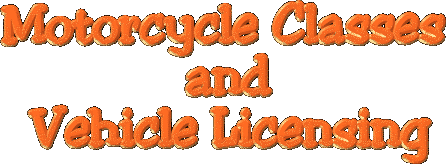


There are four classes of motorized two-wheeled vehicles in Japan, with different licensing requirements, rules, and such. The classes are demarked by engine size.
The Motor Vehicle Law (SHARYOUHOU, probably governs licencing and registration issues) demarks them into three classes, while the Road Traffic Law (DOUROKOUTSUU, probably governs the vehicle operation) into four.
Notes:
ENGINE SIZE: Technically, these are "up to, but not including" (so a scooter would be up to, BUT NOT INCLUDING, 50cc). However, all "50cc scooters" are really 49cc, "250cc bikes" are really 249cc, etc, so for the rest of this FAQ I'll sloff over this technical point and just say that 50cc is a gentsuki class, etc.
"SCOOTER": Most scooters are 50cc, so "scooter" and "gentsuki" are often used synonymously. However, they're not exactly the same. Some vehicles which are scooters can have engines as large as 750cc, while some motorcycles have only 50cc engines.
"GENTSUKI": The Japanese word "gentsuki" is short for what originally literally meant "bicycle with engine attached" (i.e. "moped"), and now technically means any motorized two-wheeled vehicle. However, now it's generally used to mean that class of vehicle with engines smaller than 50cc (and again, most "50cc" vehicles are really 49cc, so they're gentsuki as well).
EXPRESSWAYS: less than 125cc may not go onto expressways. Others may go, but there is an implied 80 km/h limit. Passengers are not allowed unless in a side-car.
RIGHT TURNS: Scooters doing right turns at large intersections (sometimes marked with a special sign) must do the two-step "Melbourne" right turn. This is called a NIDANKAIUSETSU (二段階右折). Rather than attempt to turn across a on-coming traffic, you rather pull mostly across the intersection and to the *left* (with right turn signal on!), waiting at what amounts to the very head of the waiting cross traffic. There will likely be a special box marked for you to wait in. When the cross-traffic light turns green, go across. That said, with few patrol cars around, many scooter riders just ignore the law unless the police are nearby. Don't assume anything!
HELMETS: Helmets (of some form) are required for all classes and all passengers, with differing requirements according to class.
POPULAR SIZES: Because of these classes, there aren't a wide variety of bike engine sizes on the market, as might be found in America. The most popular sizes (in order, by my guess): 50cc, 250cc, 400cc, 125cc, 750cc

Bike licensing, ownership transfers, license plate procurement, insurance, and such can all be rather complex affairs, requiring unbelievable amounts of paperwork. Thankfully, the bike shop will often take care of much of it for you.
LICENSE PLATES
License plate colors sometimes differ by location. However, small bikes (or big scooters) from 50-125cc (cf. BIKE CLASSES earlier) generally have a special color. Also, 125cc bikes have a white triangular mark painted somewhere on the rear body or mud guard. Motorcycles over 250cc (which require shaken) also have a green border on their license plates.
MANDATORY LIABILITY INSURANCE
All vehicles must carry some minimal amount of liability insurance. This is called JIBAISEKIHOKEN (自賠責保険). You can purchase it from a bike shop, or other insurance provider (I buy mine at my company). You get a small sticker that goes on your license plate to prove you've got it. You have no choice about this - you must buy it. There are discounts for multiple-year purchases. Penalties for riding or driving a vehicle without it are a penalty fine of up to 500,000 yen and a year in prison, not to mention immediate license suspension.
Costs (as of April, Heisei 5 [1993]):
| 12 mos. | 24 mos. | 36 mos. | |
|---|---|---|---|
| 250cc+ | 17,100 yen | 27,800 yen | N/A |
| 126-250cc | 13,650 | 21,000 yen | 28,000 yen |
| 125cc or less | 7850 yen | 9800 yen | 11,600 yen |
The insurance applies to the bike, and transfers with the bike if it sold. If the bike is decomissioned (totaled or stolen) before the insurance runs out, you can go through all kinds of paperwork to get some of your money back. It's a pain.
OTHER INSURANCE
Only an idiot would drive without extra insurance beyond the mandatory liability insurance. If you need some prompting, I have heard that the minimum legal compensational fine for causing a traffic death is on the order of 32,000,000 yen (about US$380,000). Rates (with Nippon Fire and Marine, at least, although I suspect it's an industry standard) are based upon a number of factors (this info somewhat scratchy):
Age: less than 21; 21-25; 26 or over
size of bike: scooter, 50cc-250cc, 250cc or over
how long you've insured with them.
coverage you want
One data point:
I bought extra insurance from Nippon Fire and Marine.
Personal liability (if I hurt others): unlimited coverage
Bodily injury for passenger: 10,000,000 yen/accident
Bodily injury for me: 2,000,000 yen/accident (I have national health coverage, so coverage for me isn't so important)
Cost: 3,960 yen/month.
Collision coverage would have been ridiculously expensive (on the order of 6,000 yen/month for minimal coverage).
SHAKEN
For vehicles larger than 250cc, a biyearly (every other year) inspection must be done. This is called SHAKEN (車検). The main cost components of shaken is the mandatory insurance (JIBAISEKI HOKEN) and weight tax (JYUURYOUZEI). These, plus a few miscellaneous fees can come to as low as about 35,000yen. However, in order to get the bike to pass the rather picky inspection, a lot of work might be required. Or at least required in the eyes of the bike shop (more work means more yen for them). It seems average costs are about 70,000 yen, but you can probably do it for much less by doing it yourself. See the section on SHAKEN below. Like the mandatory liability insurance, the shaken transfers with a vehicle (and is often a selling point: "comes with shaken good until next January"). Since a 250cc bike is the largest bike that doesn't require this, 250cc is the most popular size.
OTHER TAXES (YEARLY CITY TAX)
Every April, the city where you're a resident taxes you for your bike (via mail). Bummer if you buy the bike in March.
| Engine Size (cc) | Tax/Year (yen) |
|---|---|
| under 50cc | 1000 yen |
| 51-90cc | 1200 yen |
| 91-125cc | 1600 yen |
| 126-250cc | 2400 yen |
| 250cc+ | 4000 yen |
REGISTRATION TAX
125cc and below: none
126cc - 250cc: one-time 6,300 yen fee when the bike is new
251cc and up: 5000 yen for 2 years, 2500 yen/year after 10 years.
NOTE: This page contains Japanese script--if your computer's OS or browser is not set up to read it, many words will simply look like garbage. Try changing the way your browser reads the info - for example, using Firefox, click on "View", then "Character Encoding", then choose something like Japanese Shift_JIS.


Go on to the next page Driver's License Info
Go back to the last page Motorcycle Linguistic Info Info
Go back to the The Table of Contents